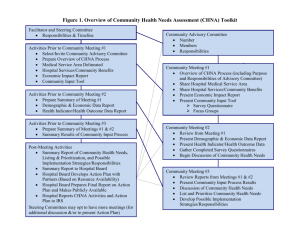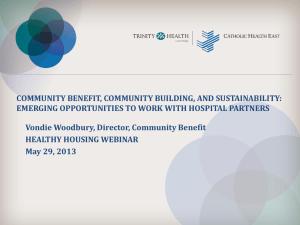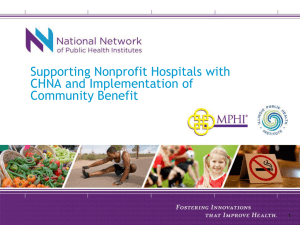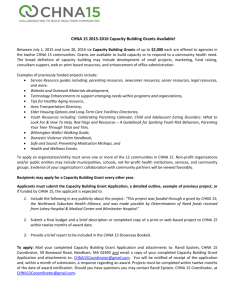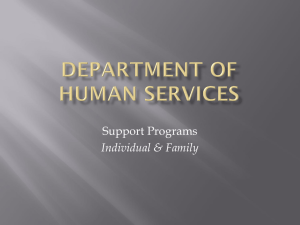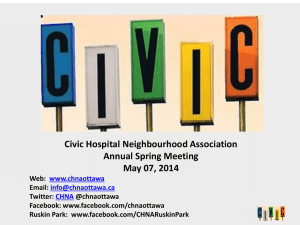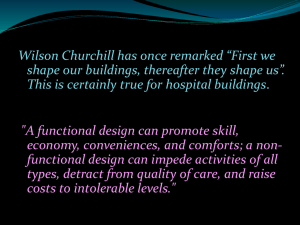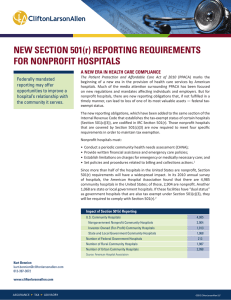Community Benefit - MI-PTE
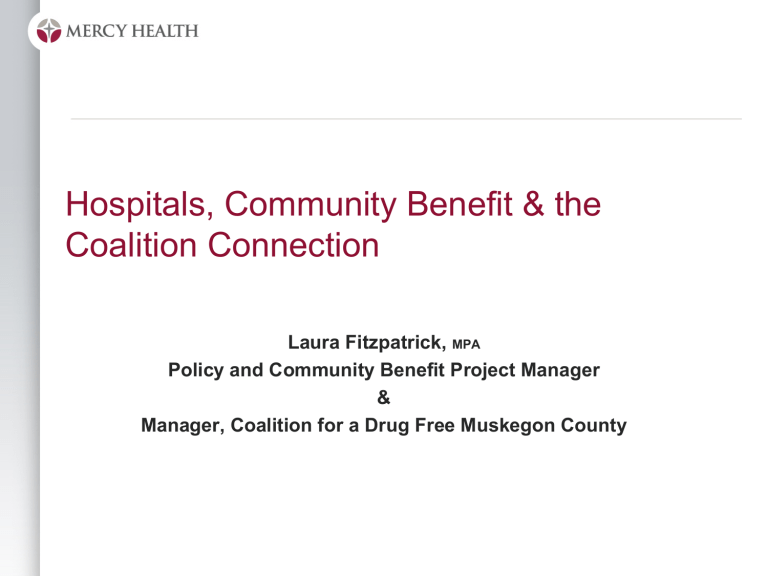
Hospitals, Community Benefit & the
Coalition Connection
Laura Fitzpatrick,
MPA
Policy and Community Benefit Project Manager
&
Manager, Coalition for a Drug Free Muskegon County
Goals for Presentation
•
Inform Coalition & Prevention Leaders about Community Benefit Rules for
Non Profit Hospitals
•
Share responsibility to know this information and how you play a role.
•
Share information requirements including assessments – examples from the region.
•
Share a real life example of CB project and DFC.
•
How to engage your local hospital – an exercise.
•
Anything else?
Non Profit Hospitals in the U.S.
•
2012 AHA Listed 2,903 Non
Profit Hospitals in the U.S.
•
Nationwide, non profit hospitals spend an average of 9% of their total expenses is on benefits to their communities known as community benefit.
•
While over 92% of community benefit budgets are on charitable care, community health improvement is growing!
Non Profit Hospitals in Michigan – Community Benefit
•
134 Community Based
Hospitals in Michigan
•
Nearly $1.9 billion in uncompensated care
– $882 million in charity care / bad debt
– $918 unreimbursed cost of Medicaid
•
$123 million in community health improvement programs
•
Michigan Hospital Association report, Feb 2013
Why Is This an Important Time to Work with My Local
Hospital?
Community Benefit: IRS Changes
•
Starting in 2006, the Congress formally started asking about non profit hospitals status. IRS responded to questions by congressional and other policymakers about non-profit community benefit claims:
– Is the community benefit standard sufficient?
– Are hospitals charitable enough?
– Should there be a level of effort test?
Minimal Community Benefit Objectives of Non Profit Hospitals
1.
Improve access to health care services
2.
Enhance the health of the community
3.
Advance medical or health care knowledge
4.
Relieve a government burden
Know the Law and Language: Schedule H
•
2009 - Schedule 990-H must be completed and filed for a Non-profit
Health System to maintain tax exempt status.
•
Accountability for Hospital System: Is the hospital truly using its
Community Benefit dollars for community health purposes?
•
It requires that:
– A community health needs assessment be conducted once every 3 years.
– This must be made available publicly on a wide basis.
– Must identify the health needs raised in the community.
– An implementation strategy must be devised identifying how the hospital will respond to the
CHNA input and where/how it will allocate its community benefit dollars.
•
Subject to IRS Audit. Failing to meet these requirements can result in a $50K fine and potential loss of tax-exempt status.
CHNA: A Community Process
Physicians/Internal
Hospital Stakeholders
Health and Human
Service Agencies
Prevention Initiatives
And Collabortives
Hospital
System
Local Government
United Way
Schools
Other Commnuity-Based
Stakeholders
Faith-Based
Organizations
Business
Community
Community Input Process, For Example:
Consumer Health Needs Survey
Implementation
Plan
Community Conversations
Focus Groups Ranking And Prioritization
Be a Resource: No Data, No Problem
Know Your Data and Where to
Find it:
– Youth Risk Behavior Survey or
Michigan Profile for Healthy
Youth.
– Kids Count
– Hospital Registry
– CHNA.org
– Public Health Department
– State Behavior Risk Survey Info
– State Department of Health
Epidemiology
– Public School Data
– UW County Health Rankings
Be the Expert and be a Resource.
Get Involved!
Who is responsible for conducting the health system’s Community
Health Needs Assessment?
– CEO, COO, CFO (CFO must file the 990)
– Hospital’s Mission Services Director
– Community Benefit Director
– President of the Board; Key Board Members
– PR Director
– Planning Director
Leverage
Your
Ask About CHNA Process
– Where do we get involved?
– What’s the plan?
• Start date
• Steering Committee
• When will community input be gathered?
• How will community input be gathered?
• Project timeline
– Will you be ranking/prioritizing identified issues?
Knowledge of the
Law!
Get Your Voice Heard…in the right way…
What the Health System Suspects of
Coalitions Members:
DATA!
MEASURABLE
OUTCOMES!
PLAN!!
What a Hospital Wants
ACTIONABLE
STEPS!!
Allegan Hospital - CHNA – July 2013
•
Ranked high need from community survey
• Substance Abuse Services
• Mental Health Service
•
Most important survey issue for improving health in Allegan
1. Decreasing substance abuse
5. Increase exercise
7. Decrease tobacco use
•
CHNA Priority Area Ranking
1. Access and affordability for low income residents
2. Mental Health & Substance Abuse
Services
Mercy Health – CHNA 2012
•
Imagine Muskegon Healthy published in June 2012 for
Muskegon, Oceana, and Newaygo
Counties.
•
Muskegon survey indicates depression as top rated issues, with high blood pressure, obesity, STD and teen pregnancy in top five issues. Preventative care and smoking issues listed in top ten priority areas.
•
Newaygo/Oceana Counties list alcohol abuse and smoking as top ranked issues.
• Mercy Health’s implementation plan
2012 Ottawa County Community Health Needs Assessment
•
Implemented by multiple hospital partners in 2012 including:
– Holland Hospital
– North Ottawa Community Health
– Spectrum Health – Zeeland Community Health
•
Not surprising Ottawa County listed as healthiest county in
Michigan!!!
• “Opportunities” for improvement found in alcohol use, obesity and teen births.
Remember these things:
•
Hospitals HAVE to address health needs identified in their CHNA.
•
Community Benefit must be spent addressing the health needs identified in the CHNA.
•
Get involved in the CHNA process. Use your voice to influence the results.
•
Demonstrate to the health system the value of your partnership in the
CHNA process.
•
Consider how your coalition may benefit directly from the health system’s community benefit expenditures…a collaboration with the health system helps position you for other funding opportunities.
Questions?
Aligning Coalitions with Hospital
•
Hospital mission includes collaboration and community health improvement.
•
Hospital and Coalition share many of the same goals and objectives on health specific issues.
•
Collaborative groups who use Strategic Prevention Framework (SPF) process is similar to hospital’s strategic planning.
– Data Driven
– Measurable outcomes
– Leverages multiple community players
In existence since 2004, our mission is to reduce substance abuse among youth and the entire population of Muskegon County, Michigan.
Coalition Snap Shot
•
Received $125,000 DFC grant annually from White House’s Office of National Drug Control Policy since
2005.
•
Over 42 organizations with 78 active members.
•
Required by feds to do extensive data driven community planning.
•
Leverages an additional $165,000 each year by mobilizing community.
•
$25,000 - $40,000 inkind annually from hospital.
What Do We Do?
Focus on five common environmental strategies
– Increase collaboration and leadership capacity of our community
– Change the community norm
– Reduce youth access to substances
– Change consequences of the provider & user
– Modify or change policies within systems, organizations, or the local community
DFC Muskegon’s Active Subcommittees
Youth
Development
Network
Marijuana Prevention Taskforce
A Coalition - Community Benefit Success Story
•
2009 Youth Survey Reveals 17.4% of youth trying prescriptions not prescribed to them.
•
National push prompts coalition to look at disposal and education projects for consideration.
•
Sept 17, 2009 DFC called a meeting.
•
17 people showed up with six from hospital.
DFC Planning to Implementation Opportunity: Disposal
• Logic Model reveals disposal in several strategies.
• Coalition called for action plan and brought hospital and community together.
• New interaction exiting for hospital personnel.
• Hospital’s PR department provides media plan and implementation.
• Hospital sponsors first events.
26
Opportunity: Financial Resources
•
Key leaders from Lakeshore Health Network emerged.
•
To get MAMDP started, hospital underwrote first two events.
•
Helped develop a resource development plan.
•
Hospital contract management helped work with existing disposal contractors.
•
Sustainability planning leads to long term hospital resources.
Mercy Health - Departments Involved in MAMDP
•
Lakeshore Health Network
•
Lakeshore Family Medicine
•
Mercy Health Pharmacy
Department
•
Mercy Health Public Relations
Department
•
Muskegon Community Health
Project
•
Senior Leadership Team
•
Purchasing
•
Development Office
•
$24,000 in first year alone!
Opportunity : In Kind Support
Hospital’s PR Department
•
Branding
•
Flyers
•
Press Release
•
Website
•
Powerpoint Templates
•
Banners
Mercy’s Pharmacy Department
•
Recruitment and coordination of all pharmacists for events.
•
Investigated regulations.
•
Tracks all intake of all drugs at events.
•
Initiated permanent daily collection.
•
Attached fliers to over 5,000 patient bags.
•
Pharmacy becomes experts on disposed materials.
Over 900,000 pills counted and categorized!
Educational Opportunities with Docs
•
Source Reduction Efforts
– 2 CME Education for physicians on prescribing practices with information about wasted meds.
– 60 plus physicians attending events
– Advocating with health plans to change ability to prescribe 90 days on first.
•
Physician / Enforcement communication workgroup established
31
MAMDP Success
•
Leads collaborative opportunities in other areas
– Over 12,000 pounds collected, 1,100 of controlled
– Coalition partners called on often for other things
– ER / Trauma Center and potential SBRIT Project
– MH & Trinity Health Board of Directors engaged in effort
– MAMDP featured in national articles / DEA Takeback Day
– Carrie Uthe, Chair of the Subcommittee counts work under community benefit and will sustain group.
Issues to consider....
•
Not all hospitals embrace community initiatives.
•
Leaders and staff may not see the connection.
•
Hospitals governed by strict regulations.
– HIPAA, IRS, HHS, Joint Commission, CMS
•
What has your history been?
•
Who is best suited to approach hospital?
33
Lets Practice Engaging Your Hospital
Share
THANK YOU!
Laura Fitzpatrick,
MPA
Advocacy and Community Benefit Project Manager
Mercy Health – Health Project
565 W. Western Avenue
Muskegon, Michigan 49440
(231)672-3207 fitzpalm@mercyhealth.com
